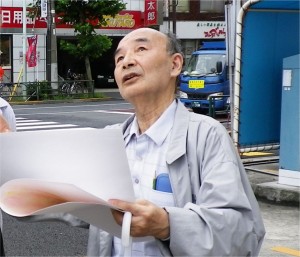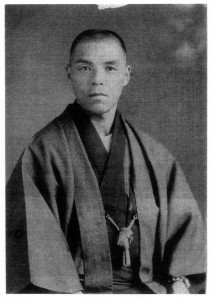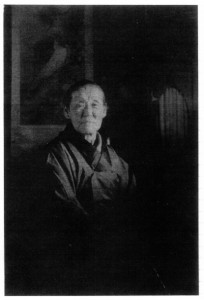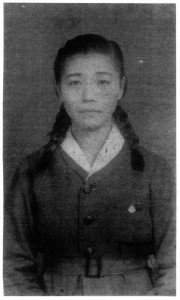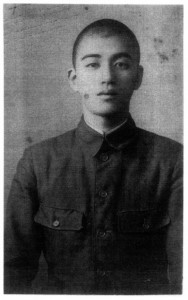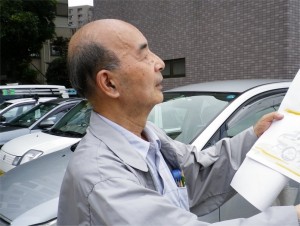The following is a translation of a letter received from Masaharu Ohtake on October 12, 2010. Mr. Ohtake describes his experiences during the March 10, 1945 incendiary air raid on Tokyo.
The Air Raid on Sunamachi
In those days, my family lived at Minami Sunamachi 1-958 in the Joto Ward (now Koto Ward). However, four out of the six of us were to be killed during the war. My father, older sister, and grandmother would become air raid victims and my older brother would die as a soldier.
My father, Kazuo Ohtake (38 years old at the time), was drafted into the army and the people of our neighborhood gave him a great sendoff in May 1938. The war with China had escalated seriously during the previous year. I was in my second year of elementary school.
Fortunately, my father returned safely two years later and was able to continue the family business (a soba noodle shop). However, after the Pacific War began in 1941, it became impossible to continue the business due to the industrial readjustment laws, so my father eventually began to work in a neighborhood factory instead. I became a junior high school student in 1943 just as the tides of war were beginning to turn against Japan. The Americans landed on Saipan in June 1944 and from this time on the home islands would be exposed to fierce air raids.
My brother, Mitsutaro, was born in 1925 and drafted in October 1944 because the laws had been changed to allow conscription at nineteen rather than twenty years of age. He was sent to China a month later. My mother later told me that my father had expressed concern to her over the poor manner in which Mitsutaro’s unit had been equipped. After returning from seeing my brother off, he confided to my mother that their preparation “just wasn’t enough.”
On November 1, 1945 I saw the first B-29 to reach Tokyo. It flew over the city on a reconnaissance mission untroubled at an altitude of 10,000 meters. I gazed up at the cloud it left in its wake.
On November 24, a formation of B-29s arrived to attack the Nakajima Aircraft plant in Musashino and bombs were dropped over Sunamachi on November 27. Some schoolchildren and teachers were killed, but this was only the beginning. Sunamachi was to be targeted frequently in the future with more fatalities to come. The area was hit particularly hard on February 15 and March 4 of 1945, but throughout this period our house remained safe.
However, the fateful day finally arrived.
The raid during the early hours of March 10 was unlike any previous raid. From about ten o’clock the previous night, “Eastern Military Announcements” were repeatedly made on the radio regarding enemy aircraft circling off the coast of the Boso Peninsula. Although it was eventually reported that these aircraft had left the vicinity, we soon heard the sound of an air raid siren.
I quickly entered the air raid shelter our family had dug under the veranda, but I soon heard my mother shouting: “It’s not going to be safe in there!” so I got back out. I was amazed at what I saw. The entire northwestern sky was aglow with a red light produced by huge columns of flames. People were already beginning to flee to our area from the neighborhoods of Fukakawa. There was a large street in front of our house and many neighbors were taking shelter in the trenches dug along it. I could hear them repeatedly chanting “Samuharasama, Samuharasama…” In those days, the mothers of the neighborhood all decorated their family altars with papers on which the four characters for “Samuhara” had been written. This was supposed to ward off bombs in the event of an air raid and is the origin of the “Samuharasama” chant I heard.
The B-29s flew directly over our heads at a very low altitude. They were moving from the direction of the Kasai Bridge (to our east) to the area of Kiba. Their massive wings seemed to blot out the sky as the bombers were illuminated by the searchlights below. Suddenly the entire area lit up as if it were midday. Flares had been dropped from the bombers and they were immediately followed by a hail of incendiaries. The seasonal northwesterly winds blew these bombs in the direction of the Onagigawa freight line’s railroad tracks. Some fell in the area of Kita-Sunamachi (Icchome) as well, but volunteer firefighters were able to extinguish them.
My father soon returned from the headquarters of the firefighting squad he belonged to. All the men had decided to send their family members off to find shelter, but stay behind themselves to fight off the flames as best they could. My grandmother, Koto Arai (79), and my older sister, Hatsue (17, a fourth year student at Joto Girls’ High School), followed my father’s order to head for Sunamachi Elementary School—a part of which had already been burned down in February. I fled in the company of Kazuo, the boy next door, who was a year older than me. Before leaving, we hurriedly loaded futons and other belongings onto a large two-wheeled cart that my mother had borrowed from the owner of a tea shop in the neighborhood.
By the time we had gotten as far as the railroad crossing just down the street, everything had changed. We could hear the sound of the wind groaning and the cloud of sparks it continually blew pummeled into our bodies—the wind was so strong that the sparks were flying horizontally. An updraft blew a ladder skyward and horses that had been released from a large stable in the neighborhood ran about in every direction. Crowds of people were also fleeing with their own two-wheeled and bicycle carts. There was no way for us to press forward loaded down with our baggage, so I abandoned my family’s belongings along with the cart itself.
Kazuo and I then tried to return from the vicinity of the Sakaigawa intersection to Sunamachi Elementary School. Unfortunately, when we had gotten as far as the fire station just in front of the school, we were stopped by firemen who had their hands held out at their sides and were admonishing everyone to return the way they had come. Unable to rest, we headed back to the Sakaigawa intersection through the ever-increasing clouds of smoke.
Fires were breaking out all around us. I soaked a rag I was carrying in the liquid remaining in the bottom of a firefighting water trough we passed and held the rag to my face. We continued south like this through the fires that were erupting on both sides. We went down Meiji Street and over Danjobashi Bridge. After a kilometer or so of nonstop running we reached Nissoh Bridge. On the way, we were hit by a flying sheet of tinplate and almost knocked into the flames, but because there were two of us we were able to stand our ground.
However, once we got to Nissoh Bridge, Kazuo and I were once again confronted by firemen with arms outstretched and declaring that we couldn’t go any further down that road. With no other options available, all we could do was risk everything in a retreat back to the direction we had come from.
Bright red flames were being disgorged through the windows of Nihon Soda’s Sunamachi factory. There was another factory beyond it on the opposite side of the road. Glancing in that direction, we noticed a vacant lot adjacent to the building in which a small group of people were taking shelter. We ran to that area and huddled down like the rest of the people were doing. I later found out that the factory was the Kuroiwa Steel Mill. As the factory itself burned furiously, a horse standing beside it began to urinate. The mist was blown on us as we huddled nearby.
It must have been two or three hours that we waited for the fires to run out of fuel. Once everything had burned out and a pale light began to illuminate our surroundings, people in the vacant lot began to file out singly or in pairs. We stepped out into the wide thoroughfare as well.
The area was now littered with what looked like mannequins. At first I thought that perhaps the B-29s had dropped them, but by the time we reached Danjobashi Bridge I had realized that these were all bodies of people who had been burned to death. I saw another mass of bodies under the bridge—people who had drowned in the river. The ropes holding rafts together had burned away and the logs were a disorganized mess. The center of these logs had all burned away leaving just their outer shells to float in the water.
When we returned to the Sakaigawa intersection, we saw a fire truck buried under a mountain of blackened bones. It looked some kind of terrifying artwork. One couldn’t help wondering just how the pile of bodies had been able to reach such a height.
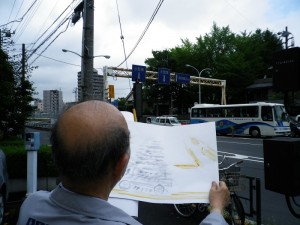
Mr. Ohtake points out where he saw the mountain of blackened corpses atop a fire engine. 消防車の上に積みあがった死体の山があった場所を案内する大竹正春氏。
The fierce winds of the night had completely disappeared and we could now see the sun rising darkly over the Kasaibashi area. Near the tracks of the freight line we found two large iron wheels in the place where our cart should have been. The wheels remained in that very spot for over twenty years after the war ended. Standing at the railroad crossing itself and looking in the direction of my house, I could see that the area was nothing but a burned out wasteland. The little hope I had had that my house might be intact was obliterated.
When I reached the spot where my house should have been, there wasn’t even a charred pillar remaining. Everything was gone and I was surprised at just how small an area of land the building had occupied. A large shipment of rice that the shop next door had just received was now a pile of smoldering blackness to which passersby and neighborhood residents were attracted as they sought something to warm their bodies.
My mother Aki (43) had largely been blinded but she managed to somehow stumble back to the site of our house with the aid of a piece of wood she was using as a cane. I remember her body shaking as she related how she had managed to survive by spending the night submerged in a firefighting water trench near Sunamachi Elementary School. In this way, my mother and I were able to meet again, but, no matter how long we waited, my father, sister and grandmother never returned.
My mother and I began our search for the three of them the next day. When passing by the entrance to Sunamachi Elementary School, we found my sister’s body lying on top of a pile of bodies that had collected in a ditch at the side of the road. A man was using a fire hook to pull bodies out of the ditch and we asked him to help us get her body out. We laid my sister’s corpse near the wall surrounding the school and covered it with a sheet of burned tinplate. Then we asked the man to put the corpse near my sister’s if he were to find any bodies of old women in the ditch as well.
We returned the next day to find that the man had indeed found my grandmother’s body and laid it near my sister as we’d requested. While my mother lay on the ground weeping, an elderly woman who happened to pass by held out the scissors she was carrying: “Please use these if you’d like to cut off some of their hair and fingernails.”
Many people would never even be able to find the bodies of their loved ones. We were lucky in that respect. However, when we went again the next day, the bodies had already been taken away. Even after the war ended, we were never able to locate their remains.
My mother’s last hope was that my father might be hospitalized somewhere, so she spent her energy in a search of the area’s hospitals. I remember accompanying her to the Doai, Kudanzaka, and Toritsu Ebara hospitals among others. We never found him.
In addition, my sister-in-law, Mitsuko Nakabayashi (32), had also gone missing. She had moved to a nearby neighborhood six months ago. Although she had sometimes visited our house, we’d been unable to do anything to help her that night. I still feel pangs of guilt regarding that even today.
On April 30, my father’s mother (Miono Ohtake, 67), who lived in Hamamatsu, was killed by a bomb dropped by a B-29. At the same time, a cousin my same age was also injured badly and lost three fingers on her left hand. My mother and I had just visited them at the end of March to tell them about my father’s death. At that time, everyone had been fine and things seemed quiet in Hamamatsu. Through subsequent raids, however, that city was also reduced to a burned out wasteland.
When the end of the war came on August 15, I was living at an uncle’s house in Suginami Ward. We waited anxiously for my brother Mitsutaro to return from the front. However, we were notified in May 1946 that my brother had died from an illness in the Shanxi Province of China on August 19, 1945. My mother couldn’t bear this news after having waited for him to return for so long and she wept bitterly. Regarding the pain inflicted on our family by the war, my mother would later write that she “had earnestly desired to follow them all into the grave.”
Because our house had burned down on March 10, we spent the next night at my uncle’s home in Suginami Ward. Everyday afterwards I would take a train on the Chuo line as far as Ochanomizu Station. Getting off there, I would walk down Keiyo Street and pass through the Ryogoku and Kinshicho areas until I came to the Senda-cho neighborhood where my sister in-law’s house would have been had it not burned down. From there I walked down to Sunamachi. I sometimes took a different route through Kameido and Ohshima or over Kiyosu Bridge and down Kiyosuna Street. For about a week after the raid the Sobu Line trains were stopped and I think it was several months before the Toden trains were moving again. You had no choice but to walk everywhere.
I had a strong desire to know exactly what had happened, but the newspapers and radio made no mention of the extent of the damage inflicted by the raid. And it was much the same after the war ended—the country focused on recovery and economic growth without even giving a second thought to the victims of the air raids. After the war, Tokyo was repopulated by an influx of newcomers, but many of the air raid victims were never able to return to their homes.
Neither the national government nor the metropolitan government and ward offices made any attempt whatsoever to record the details of who had died how and where. The bereaved, the wounded, even the newly-created orphans, many of whom had lost their siblings as well, were forgotten by the authorities.
Tokyo Memorial Hall itself was originally constructed to memorialize victims of the Great Kanto Earthquake. The exhibits in the adjacent Yokoami Park and Reconstruction Hall are the same today as they were in those days–mostly focused on the earthquake. In spite of the memorial structure added to the grounds in 2001 that houses a list of war victims’ names, one can never quite get over the feeling that it isn’t really an appropriate location for remembering the war victims. I just don’t think it can be said that the souls of the 100,000 people whose remains are contained in 450 urns and housed inside the memorial tower along with the earthquake victims are resting peacefully.
The wounded hearts of the bereaved, who have long desired a separate memorial facility, have likewise never healed.
